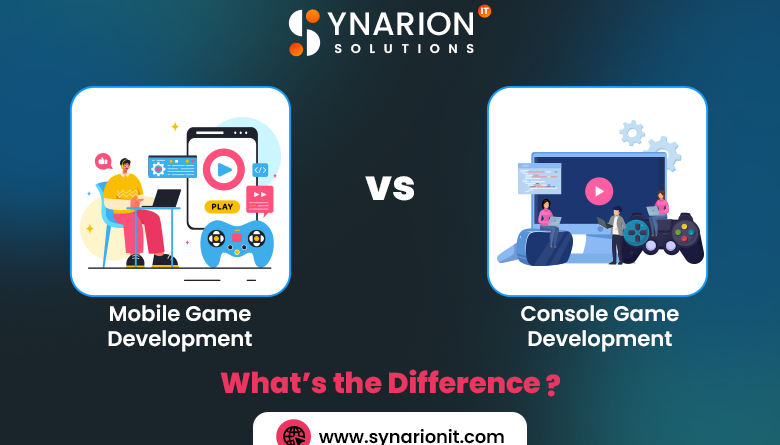Mobile Game Development vs Console Game Development: What’s the Difference?
The world of gaming has evolved rapidly over the past few decades, leading to the rise of two major platforms that dominate the industry today: mobile gaming and console gaming. While both offer immersive gaming experiences, the development processes, challenges, and opportunities for each platform vary significantly. Understanding the differences between mobile game development and console game development is crucial for game developers, publishers, and players alike.
What is Mobile Game Development?
Mobile game development refers to the creation of video games designed to run on smartphones and tablets. These devices operate on mobile operating systems like iOS (for Apple devices) and Android (for most other smartphones and tablets). Mobile games range from simple, casual games like puzzles and match-three games to more complex titles featuring rich graphics and multiplayer capabilities.
The primary allure of mobile games is their accessibility and convenience. Players can enjoy these games anytime and anywhere, whether they are commuting, waiting in line, or relaxing at home. The mobile gaming industry has exploded in recent years, thanks in part to the massive reach of mobile devices and app stores that make downloading games quick and easy. Popular examples include games like Candy Crush, Clash of Clans, and Pokémon GO.
What is Console Game Development?
Console game development, on the other hand, involves the creation of games for dedicated gaming consoles such as the PlayStation, Xbox, and Nintendo Switch. These consoles are standalone hardware units connected to a TV or monitor, offering a more stationary gaming experience compared to mobile devices. Console games often have higher production values, featuring cutting-edge graphics, detailed worlds, and intricate gameplay mechanics.
Developing games for consoles has traditionally involved working closely with the hardware manufacturers like Sony, Microsoft, or Nintendo to optimize the game for specific systems. Console games tend to offer more immersive experiences, with complex narratives, highly detailed graphics, and advanced gameplay features. Some iconic console games include titles like The Legend of Zelda, Halo, and God of War.
Key Differences Between Mobile and Console Game Development
Now, let’s explore the major differences between mobile and console game development in greater detail.
Platform and Hardware Constraints
One of the most significant differences lies in the platform and hardware constraints of each. Mobile devices have limited processing power, memory, and storage compared to consoles. Mobile devices are designed for portability and convenience, which means that developers must create games that are optimized to work within these limitations. Developers often need to balance performance with graphical fidelity, as mobile devices cannot handle the same level of detailed visuals as a console.
In contrast, consoles are specifically designed for gaming and feature dedicated processors, powerful GPUs, and larger memory capacities. This allows console game developers to create more graphically intense and complex games. The hardware capabilities of consoles allow for intricate world-building, better artificial intelligence, and more detailed graphics, often resulting in a more visually immersive gaming experience.
Game Complexity and Scope
Mobile games tend to be simpler and more accessible than console games. Many mobile games are designed with casual gamers in mind, featuring easy-to-learn mechanics, quick play sessions, and addictive gameplay loops. Games like Flappy Bird or Subway Surfers are simple to pick up and play, but they may lack the depth and complexity of traditional console games.
Console games, on the other hand, are typically more complex and feature-rich. These games can take hours or even days to complete, offering intricate plots, side quests, and extensive open worlds. For example, a game like The Witcher 3 offers deep character development, complex storylines, and a vast open world with many layers of gameplay, which is much harder to achieve on a mobile platform due to hardware constraints.
User Interface and Control Mechanisms
The control mechanisms for mobile and console games differ significantly. Mobile games rely heavily on touchscreens, swiping, and tapping as the primary means of interaction. The lack of physical buttons means that developers need to be creative in designing intuitive controls that work well with a touchscreen interface. Many mobile games also incorporate tilt and motion-based controls, utilizing the sensors found in modern smartphones.
In contrast, console games often rely on traditional physical controllers with buttons, joysticks, and triggers. These controllers allow for more nuanced control over character movements, camera angles, and other gameplay mechanics, making them better suited for complex games. The tactile feel of a controller also contributes to the immersion, as players can feel more connected to the game world.
Monetization Models
Monetization strategies vary greatly between mobile and console games. Mobile game developers often use a free-to-play model with in-app purchases, advertisements, or microtransactions to generate revenue. Players can download games for free but are encouraged to make purchases for cosmetic items, additional levels, or power-ups. This model has been highly successful, with games like Fortnite and PUBG Mobile earning massive profits through microtransactions.
Console games typically follow a more traditional model, with players paying a one-time upfront cost for the game. Although downloadable content (DLC) and season passes are also common, these games generally do not rely as heavily on in-game purchases. The upfront cost of console games reflects their larger production budgets and the immersive experiences they provide.
Development Time and Budget
Developing games for mobile devices tends to be quicker and more cost-effective compared to console games. The relatively simple game mechanics, smaller scope, and lower production values mean that developers can release mobile games in a shorter timeframe. As a result, mobile game development often requires a smaller team and a lower budget.
In contrast, console game development involves larger teams, extended production timelines, and a much higher budget. Console games require more resources for things like high-quality graphics, complex AI, and extensive game testing. The development cycle for a console game can take several years, and the cost can run into millions of dollars, especially for AAA titles.
Conclusion
In summary, while both mobile and console game development offers unique challenges and opportunities, the key differences lie in hardware limitations, game complexity, control mechanisms, monetization models, and development time. Mobile game development is often quicker, more accessible, and designed for casual gamers, while console game development focuses on delivering more immersive, complex, and graphically intense experiences. Understanding these differences helps developers choose the right platform for their games, ensuring a more tailored and optimized gaming experience for players.




